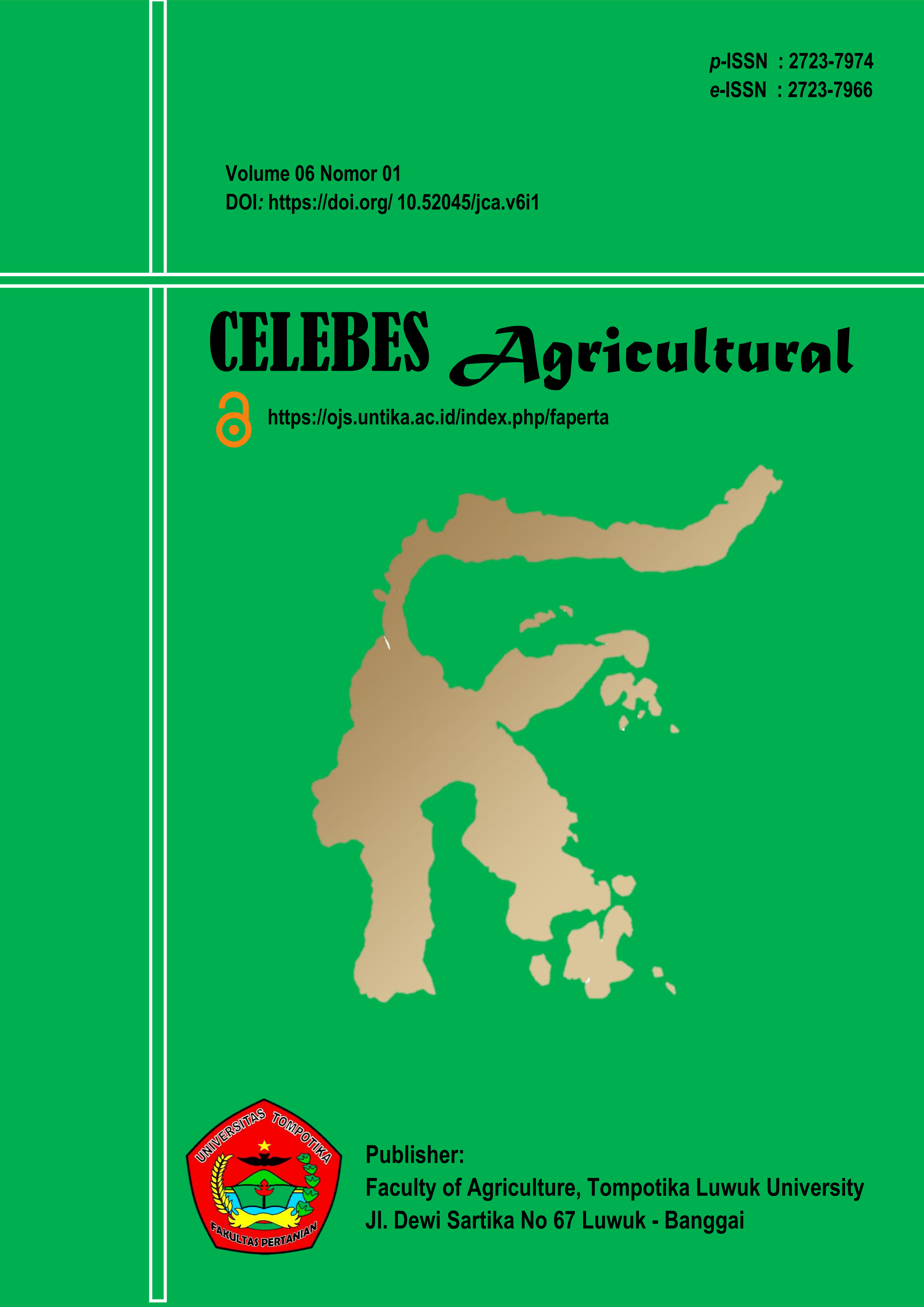Arthropod Insect Communities in Several Different Habitats
https://doi.org/10.52045/jca.v6i1.1009
Keywords:
Keywords: diversity, arthropods, agricultural habitats, pitfall trap, Bray–CurtisAbstract
Interactions between biotic and abiotic components in ecosystems influence insect mortality, natality, and dispersal, thereby making species composition dynamic. The presence and abundance of arthropods in agricultural systems cannot be precisely predicted, as they are affected by numerous factors such as cropping practices, habitat type, plant age, and interspecific interactions among arthropods. This study aimed to examine the diversity, abundance, and community composition of arthropods across four agricultural habitat types: maize, soybean, weeds, and soil surface. Arthropod samples were collected through direct observation, sweep netting, and pitfall traps. The findings revealed that insects from the order Hemiptera had the highest abundance in comparison to other orders, with 51 individuals recorded on maize and 409 on soybean. In contrast, 244 insects were found on weeds, dominated by the order Diptera. On the soil surface, a total of 482 insects were collected, predominantly from the order Collembola. The Collembola order exhibited the lowest values in terms of relative diversity index (H′), dominance (D), and evenness (E) compared to other habitats. The Bray–Curtis similarity index between soybean and weed habitats was the highest (0.205), indicating a greater similarity in arthropod composition between these two habitats. Conversely, the lowest similarity value (0.043) was observed between soybean and soil surface habitats, suggesting a greater difference in arthropod community composition.
Downloads
References
Afifah, L., Hidayat, P., Buchori, D., Marwoto, M. & Rahardjo, B. T. 2015. Pengaruh Perbedaan Pengelolaan Agroekosistem Tanaman Terhadap Struktur Komunitas Serangga Pada Pertanaman Kedelai Di Ngale, Kabupaten Ngawi, Jawa Timur. Jurnal Hama dan Penyakit Tumbuhan Tropika. 15(1), 53-64, https://doi.org/10.23960/j.hptt.11553-64
Altieri, M.A. & Nicholls, C.I. 2004. Biodiversity and Pest Management in Agroecosystems, 2nd ed. Binghamton (NY): The Harworth Press.
Campera, M., Widianingsih, W., Giordano, C., & Nekaris, K. A. I. 2024. Land-use type influences terrestrial arthropod community composition in Balinese agroforestry systems. Land, 13(4), 493. https://doi.org/10.3390/land13040493
Fountain, M. T., Brown, V. K., Gange, A. C., Symondson, W. O. C., & Murray, P. J. 2007. The effects of the insecticide chlorpyrifos on Collembola in laboratory and field conditions. Environmental Pollution, 146(2), 520–526. https://doi.org/10.1016/j.envpol.2006.06.013
Gunstone, T., Cornelisse, T., Klein, K., Dubey, A., & Donley, N. 2021. Pesticides and soil invertebrates: A hazard assessment. Frontiers in Environmental Science, 9, 643847. https://doi.org/10.3389/fenvs.2021.643847
Gurr, G. M., Wratten, S. D., Landis, D. A. & You, M. 2017. Habitat management to suppress pest populations: progress and prospects. Annual review of entomology, 62(1), 91-109. https://doi.org/10.1146/annurev-ento-031616-035050
Hamid, H. 2012. Struktur komunitas serangga herbivora dan parasitoid pada polong tanaman kacang-kacangan (Fabaceae) di Padang. Jurnal Entomologi Indonesia, 9(2), 88–94. https://doi.org/10.5994/jei.9.2.88
Hendrival, & Khalid, A. 2017. Perbandingan keanekaragaman Hymenoptera parasitoid pada agroekosistem kedelai dengan aplikasi dan tanpa aplikasi insektisida. Journal of Biology, 10(1), 48–58.
Indriyati, & Wibowo, L. 2008. Keragaman dan kemelimpahan Collembola serta arthropoda tanah di lahan sawah organik dan konvensional pada masa bera. J. HPT Tropika, 8(2), 110–116. https://doi.org/10.23960/j.hptt.28110-116
Kafrianto, M., Hasriyanty, & Pasaru, F. (2018). Keanekaragaman serangga air di aliran Sungai Pondo Lembah Palu. Jurnal Agroland, 25(3), 238–247.
Komi, M. H., Toana, M. H., & Yunus, M. 2015. Keanekaragaman arthropoda dan kepadatan populasi imago penggerek batang padi putih Scirpophaga innotata Wlk. (Lepidoptera: Pyralidae) pada lingkungan pertanaman padi yang berbeda di Kabupaten Parigi Moutong. e-Jurnal Agrotekbis, 3(5), 612–621.
Mahendra, R., Suprapta, D. N., & Latifah, N. 2023. Analisis keanekaragaman hayati musuh alami pada pertanaman kedelai di lahan IPM dan konvensional. Jurnal Tanaman Pangan dan Perkebunan, 1(1), 15–22. https://jtpp.ub.ac.id/index.php/jtpp/article/view/160
Magurran, A. E. 2004. Measuring Biology Diversity. Oxford (GB): Blackwell Publishing.
Nasution, A. P. 2012. Kelimpahan artropoda predator permukaan tanah pada tiga ekosistem pertanaman [Skripsi]. Bogor (ID): IPB University.
Ojija, F. 2016. Diversity And Abundance Of Arthropods At Mbeya University Of Science And Technology, Tanzania. International Journal of Scientific & Technology Research, 5(9), 201–210.
Oka, I. N. 1995. Pengendalian hama terpadu dan implementasinya di Indonesia. Yogyakarta (ID): Universitas Gadjah Mada Press.
Purwantara, F., & Rauf, A. 2000. Pengaruh samping aplikasi insektisida terhadap predator dan parasitoid pada pertanaman kedelai di Cianjur. Buletin Hama dan Penyakit Tumbuhan, 12, 35–43.
Suhardjono, Y. R., Deharveng, L. & Bedos, A. 2012. Collembola (Ekorpegas). Bogor (ID): Vegamedia
Tsuruda, J. M., Andow, D. A., & Cardinale, B. J. 2025. Semi-natural habitats promote beneficial arthropods in crop fields: Evidence from meta-analysis. Journal of Applied Entomology, 149(1), 35–47. https://doi.org/10.1111/jen.13364
Warino, J., Widyastuti, R., Suhardjono, Y. R., & Nugroho, B. 2017. Keanekaragaman dan kelimpahan Collembola pada perkebunan kelapa sawit di Kecamatan Bajubang, Jambi. Jurnal Entomologi Indonesia, 14(2), 51–57. https://doi.org/10.5994/jei.14.2.51
Winasa, I. W. 2001. Arthropoda predator penghuni permukaan tanah di pertanaman kedelai: Kelimpahan, pemangsaan, dan pengaruh praktek budidaya tanaman [Disertasi]. Bogor (ID): IPB University.
Downloads
Published
How to Cite
Issue
Section
License
Copyright (c) 2025 Sri Ayu Anggita, Muhammad Harianto, Nurul Wiridannisaa, Prihatin, Jean Nihana Manalu

This work is licensed under a Creative Commons Attribution 4.0 International License.





